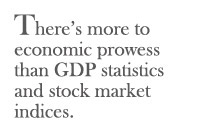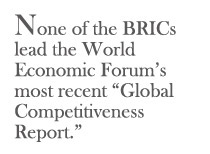What About the BRICs?
What About the BRICs?

NEW YORK: The current economic crisis has provided fresh fuel to the debate over the feared decline of the West and rise of the East. The so-called BRICs – Brazil, Russia, India, and China – are often touted as the putative economic winners. A look behind the numbers, though, suggests proclaiming these countries victors may be premature.
The numbers aren’t encouraging. The World Bank’s gloomy forecasts see global GDP falling a record 2.9 percent in 2009, along with deteriorating current account balances, increased debt, soaring unemployment, gyrating stock markets and tumbling business confidence. Yes, there may be a few “green shoots” of recovery. China’s stimulus efforts – a rapid expansion of fixed investment and credit to the state sector fueled by massive foreign reserves – seem to have had a predictable positive, if likely short-term, effect. Perhaps broader, but still modest, recoveries in 2010 and 2011 are in the cards.

But the way to full recovery is unclear. The global economy is at some kind of tipping or inflection point, a moment of paradigm shift. If the Anglo-American model of finance capital is yet another god that failed, so too the alternatives: Japanese networked capitalism, Euro-dirigisme, or various flavors of state capitalism (perhaps combined, as in China, with authoritarian politics) have not been widely embraced.
At this point, enter the BRICs. Before the severity of the looming economic storm was clear, the BRICs were the darlings of the investment class. They were first lumped together in an influential Goldman Sachs research report in 2001. Goldman forecast that their continuing GDP growth could outpace the rest of the world, with the GDPs of China and India surpassing those of the major Western economic powers before mid-century. To be sure, these “emerging markets” were not seen as risk free, but with their scale – continental powers with large populations and records of substantial economic growth – they looked attractive. Especially to punters playing the markets. If Goldman liked them, how could you go wrong? The economic press loved it.

But there’s more to economic prowess than GDP statistics and stock market indices. This is not to gainsay the BRICs’ – especially China and India’s – economic momentum and remarkable development. Visitors to China cannot be but wowed by what metropolitan colossi Beijing and Shanghai have become. India’s IT prowess dominates. But sustainable growth and economic leadership will ultimately have to be based on business environment fundamentals. International metrics that go beyond GDP suggest the BRICs have a long way to go.
Take, for starters, corruption, the capricious acid that eats away at business confidence, rule of law and fair dealing. None of the BRICs rank very high in the 180-country survey published by Transparency International. Brazil and India come in at 80th and 85th place, roughly comparable to Burkina Faso, Saudi Arabia and Panama. Russia is almost at the bottom, ranking 147th – Kenya and Syria are neighbors. China does best, at 72nd place – right down there with Mexico. And if the current murky scandal involving China’s steel industry which has ensnared executives from Australia’s Rio Tinto shows anything, it’s that corruption and the opacity of China’s legal system can rust business confidence away.
If there’s corruption, then it’s not so easy to do business there. The World Bank studies “the ease of doing business” in 181 countries. Brazil, Russia and India stand between 120 to125 in those league tables. China comes in somewhat better, in 83rd place – a little higher than Belarus, a little lower than Kenya. The most difficult issues? Dealing with the local authorities in Russia and China (maybe a little additional “help” is required?); enforcing contracts in India’s clogged legal system, and, interestingly enough, taxes in Brazil.

None of the BRICs lead the World Economic Forum’s most recent “Global Competitiveness Report” (GCR). This sophisticated survey pulls together a large range of business environment variables, including social and political stability, economic concerns, technological sophistication and management quality. Of the 134 countries ranked, China comes in at 30th place (comparable to Spain); India and Russia land at 50th and 51st places respectively (about the same as Italy); and Brazil checks in at 64th place, close to Turkey and Kazakhstan. The GCR points out that all of these environments are plagued by bureaucracy, corruption, changeable business policies and problems with finance. (Not that the G-8 countries are 100% clean here either!).
And if social stability is a metric, then the fires that have fueled tragic communal violence in India and, more recently, China (which also suffers from tens of thousands “mass incidents” of citizens protesting corruption) have to be a concern. You don’t push too hard against entrenched interests in Russia, where arbitrary arrest and even murder can be the outcome.
Should we really be surprised? From these perspectives, the BRICs don’t look that strong. These countries are all, in one way or another, still developing. Brazil, India and China have large problems of income distribution (more unequal than even the US), issues exacerbated by large but low productivity agricultural sectors and urban squalor. Brazil and Russia rank at midpoint in the 179 country United Nations’ Human Development Index; China is just slightly below and India, alas, is almost at the bottom. And Russia and China face demographic challenges. China is aging. Russia has even more severe population problems – it’s disappearing.

But could they be considered a bloc? Their economic, social and political systems differ considerably: Brazil’s economy is based on agriculture; India’s on services; Russia’s on price-sensitive energy resources, and China on manufactures for export. China and Russia have had problematic political relations; the disputed borders between China and India are still hot (and let’s not forget New Delhi’s concerns about the cozy relationship between Beijing and Islamabad). What do they share? Growth potential. And a desire to take the Yankee dollar down a peg. Is that sufficient to suggest that the answer to the world’s woes be found with the BRICs?
BRIC officials seem to think so. In the run up to the April 2009 G-20 meeting in London they pushed their own agenda, calling for new international finance rules, reform of the IMF and the World Bank, and resurrection of the Doha round. Overall, they are pushing for a multi-polar economic order, one less dominated by the US.
The Russians called for a new international currency backed by IMF SDRs (Special Drawing Rights) – an idea also picked up by Brazil and China. Indian Prime Minister Manmohan Singh said that the eyes of the world were on India in the “hope that India would be an engine of growth for the world economy.” Chinese officials touted their own “stimulus package” and quick action, noting the superiority of China’s command system “when it comes to making vital policy decisions.”
But at a “BRIC Summit” held in Yekaterinburg in July, there was less fire – a BRIC agenda did not surface. Still, the idea of a new international reserve currency hasn’t gone away.
We raise these matters not to criticize the BRICs individually but rather to put a little realism into the crucial discussion of world economic recovery. First, they can hardly be considered a cohesive group. Second, sustainable leadership requires a sound business environment. On that score, the BRICs have a way to go.
To be sure, their equity markets seem to be doing well enough (though China’s appears to be a bubble). But there’s more to an economy than GDP projections and speculative bets about the future of a few leading companies. It’s time to retire what after all is a snappy acronym invented by an investment bank.
John Frankenstein teaches courses on Asia and international business at Brooklyn College/City University of New York.